Walk into any hardware store or scroll through Amazon, and you’ll be hit with hundreds of “power strips” and “surge protectors.” But here’s the catch: not all power strips are created equal. In fact, using the wrong one could fry your electronics, damage expensive gaming gear, or even cause a fire.
So what’s the difference between a power strip and a surge protector?
Power Strip: Simply adds more outlets. That’s it. No real protection—just more plugs.
Surge Protector: Adds outlets and defends against voltage spikes, protecting your devices from sudden surges (like lightning strikes or power grid hiccups).
In 2025, with energy demands rising and more smart devices in our homes, protecting your electronics is non-negotiable. Let’s dig into what makes a power strip “safe” and which surge protectors are actually worth your money.
If you’re plugging in your pricey electronics—laptops, gaming consoles, smart TVs, or even just your phone—you need to know that the power strip you’re using is doing more than just powering them. It should be actively protecting your devices and your home.
A “safe” power strip isn’t just about convenience—it’s about electrical safety, fire prevention, and equipment protection. Here’s what defines a safe power strip in 2025, and why you should never settle for a cheap, uncertified one.
Let’s be blunt: bad power strips are everywhere. And while they might look similar on the outside, the inside tells a very different story.
Common dangers include:
Electrical Fires – Overheating due to poor internal wiring or plastic housings.
Surge Damage – No protection means one power spike could destroy all your connected devices.
Short Circuits – Flimsy build quality increases the chance of dangerous shorts.
False Sense of Security – Many cheap strips are falsely labeled or don’t meet safety standards.
With homes packed with sensitive electronics, and many people working remotely, it’s more important than ever to use certified and properly rated protection.
To ensure your power strip is safe and effective, make sure it includes the following:
A basic power strip adds outlets. A surge protector goes further by shielding your devices from voltage spikes caused by lightning, power outages, or faulty wiring.
Look for a joule rating (more on that in the next section).
If there’s no joule rating, it’s not a surge protector—don’t buy it.
A safe power strip must include an internal circuit breaker that trips (turns off) automatically when the current draw exceeds safe levels. This feature:
Prevents overheating and fire risk.
Lets you reset the strip without replacing it.
Is especially important when connecting high-consumption devices like printers, PCs, or monitors.
Bonus: Circuit breakers are better than fuses, which burn out permanently and must be replaced.
This is non-negotiable. Safe power strips are certified by independent safety labs like:
UL (Underwriters Laboratories)
ETL (Intertek)
These certifications guarantee the product meets electrical safety standards for insulation, fire resistance, grounding, and surge protection. If it’s not UL- or ETL-listed, it hasn’t been properly tested—simple as that.
Pro tip: Look for the actual certification logo on the product or packaging, not just in the online listing.
Cheap strips often use low-grade plastic that can melt or ignite under load. Look for:
ABS or PC fire-resistant plastic
Metal housings (for commercial-grade strips)
Materials that meet Flame Retardant V-0 standards
This ensures the strip won’t contribute to the fire even if something goes wrong.
Grounding ensures that stray electrical current doesn’t fry your devices—or you. A grounded power strip has a three-prong plug and internal wiring that channels extra electricity safely to the earth.
A good surge protector will also include a “Grounded” indicator light so you know everything is correctly connected.
If you have kids or pets, extra safety matters:
Sliding safety covers protect unused outlets.
Tamper-resistant sockets prevent foreign objects from being inserted.
Low-profile plugs minimize tripping hazards and accidental unplugging.
These aren’t just gimmicks—they’re important:
“Protected” light: Lets you know surge protection is still active. If it goes out, replace the strip.
“Grounded” light: Confirms your wall outlet is wired correctly.
Audible alerts: Some high-end models beep when protection fails or during dangerous surges.
The quality of the cord is often overlooked—but it matters:
Thick, insulated cords (14-gauge or thicker) handle more current safely.
Strain relief where the cord meets the strip prevents fraying.
Cord length: Longer cords are convenient but should be heavy-duty to avoid voltage drops.
Avoid ultra-thin cords—they overheat more easily and tend to wear out faster.
While not directly related to safety, wall-mountable or under-desk strips keep cords off the floor, away from pets, feet, and liquids—reducing risks of accidents.
If you spot any of these signs, skip it immediately:
No certification marks (UL, ETL, CE).
No mention of surge protection or joule rating.
Housing feels flimsy or lightweight.
Prongs are loose or wiggle inside the socket.
Multiple poor reviews mentioning overheating or melting.
| Feature | Purpose |
|---|---|
| UL/ETL Certification | Confirms product meets safety standards |
| Surge Protection (Joules) | Protects against voltage spikes |
| Circuit Breaker | Prevents overloads and potential fires |
| Fire-Resistant Housing | Reduces flammability under heavy load |
| Grounded Plug | Channels excess electricity safely |
| Indicator Lights | Confirms protection and proper connection |
| Quality Power Cord | Handles load without overheating |
In short, a power strip is only “safe” if it goes beyond just splitting outlets. You’re trusting this device with your home, your equipment—and in some cases, your safety. Choose wisely, avoid no-name brands, and always check for these essential features. You’ll sleep better knowing your electronics (and family) are protected.
Not all surge protectors are built the same—and understanding what truly matters can be the difference between keeping your expensive devices safe and throwing them out after a power spike. Whether you’re setting up a home office, a gaming battle station, or a charging hub for your gadgets, choosing the right features will ensure both safety and functionality.
Let’s break down the key features that separate a reliable surge protector from a basic power strip—and how each one plays a vital role in protecting your electronics and improving usability.
Joules are the unit of measurement for energy absorption. In surge protectors, the joule rating indicates how much excess voltage the device can absorb before it stops protecting your equipment.
When a power surge happens (for example, due to a lightning strike or utility grid fluctuation), the surge protector absorbs the extra energy and redirects it away from your devices. The more energy it can handle, the better the protection.
Below 1000 joules
Basic protection for small devices like lamps, phone chargers, or alarm clocks.
1000–2000 joules
Medium protection suitable for TVs, routers, and office equipment.
2000–4000 joules
High protection ideal for gaming PCs, audio systems, or home theaters.
4000+ joules
Premium level protection used for servers, data centers, or mission-critical tech.
Joule capacity depletes over time. Every power spike, even a small one, reduces the total protection left. Once it’s used up, the surge protector still “works” as a power strip—but no longer provides any surge defense. That’s why it’s critical to:
Check the “protected” indicator light.
Replace your surge protector every 2–3 years, or after a known surge event.
The number of outlets you need depends on how many devices you plan to connect—but quality matters as much as quantity.
6–8 outlets: Good for standard home use.
10–12 outlets: Ideal for gaming, entertainment centers, or offices.
Individually switchable outlets: Helpful for controlling power to specific devices (and reducing phantom power drain).
Widely spaced outlets are a must if you have chunky power bricks or adapters (like those for monitors or external drives).
Rotating or pivoting outlets offer flexibility when fitting into tight spaces or behind furniture.
Modern surge protectors now include integrated USB ports—a brilliant solution for charging smartphones, tablets, earbuds, power banks, and more without needing a wall charger.
USB-A ports
Still the most common. Great for older phones and accessories.
Look for 2.4A output per port for fast charging.
USB-C ports
The new standard, especially for newer iPhones, Android devices, iPads, and laptops.
Power Delivery (PD) support is ideal—can charge even laptops and gaming handhelds like the Steam Deck or Nintendo Switch.
Choose surge protectors with smart charging chips that automatically detect the optimal current.
Avoid models with unregulated USB ports—they can damage battery health over time.
Smart surge protectors are no longer a niche gadget—they’re becoming standard in modern homes, especially for people building smart home ecosystems.
Remote Control via App
Control individual outlets or the whole strip using your phone.
Turn off appliances when not in use—perfect for energy savings and security.
Voice Control
Works with Amazon Alexa, Google Assistant, or Apple HomeKit.
Example: “Hey Google, turn off the gaming station.”
Scheduling & Automation
Automatically turn on lights at sunset or start your coffee machine at 7 a.m.
Set “vacation mode” to make your home look occupied while you’re away.
Energy Monitoring
Track how much electricity each connected device uses.
Helps identify power-hungry appliances and reduce electricity bills.
Absolutely—as long as the device is:
UL/ETL certified, and
From a reputable brand with regular firmware updates.
Avoid unbranded or off-market smart strips, as they may have poor app security and questionable build quality.
| Feature | Description | Why It Matters |
|---|---|---|
| Auto-Shutoff | Disconnects power when surge protection is depleted. | Prevents devices from being left vulnerable unknowingly. |
| Indicator Lights | Shows status of grounding and protection. | Helps you monitor functionality at a glance. |
| Reset Button | Built-in breaker can be reset if tripped. | Safer than replacing fuses or guessing why it shut off. |
| Right-Angle Plug | Flat design that hugs the wall. | Perfect for tight spaces behind desks or furniture. |
| Cord Length | Usually ranges from 3 to 12 feet. | Choose longer cords for flexibility; ensure it’s thick and insulated. |
Here’s a quick guide:
| Use Case | Must-Have Features |
|---|---|
| Gaming Setup | High joules (2000+), EMI/RFI filtering, wide outlet spacing |
| Home Office | USB ports, surge protection, smart scheduling |
| Living Room / TV | Multiple AC outlets, long cord, cable management |
| Smart Home | Voice control, app access, energy monitoring |
| Travel | Compact, USB-C port, universal voltage support |
Think of your surge protector as the first line of defense in your electrical system. It’s not just about powering your devices—it’s about protecting them, extending their lifespan, and ensuring your safety.
By prioritizing features like a high joule rating, integrated USB and smart controls, and certified surge and overload protection, you’re investing in peace of mind, convenience, and long-term savings.
With so many options on the market, finding the right surge protector can feel overwhelming. But the best picks of 2025 go beyond basic protection—they offer smart features, ergonomic design, and reliability from brands you can trust.
Below are top-rated surge protectors that deliver performance, protection, and usability across various settings—from gaming rigs to smart homes to professional workspaces.
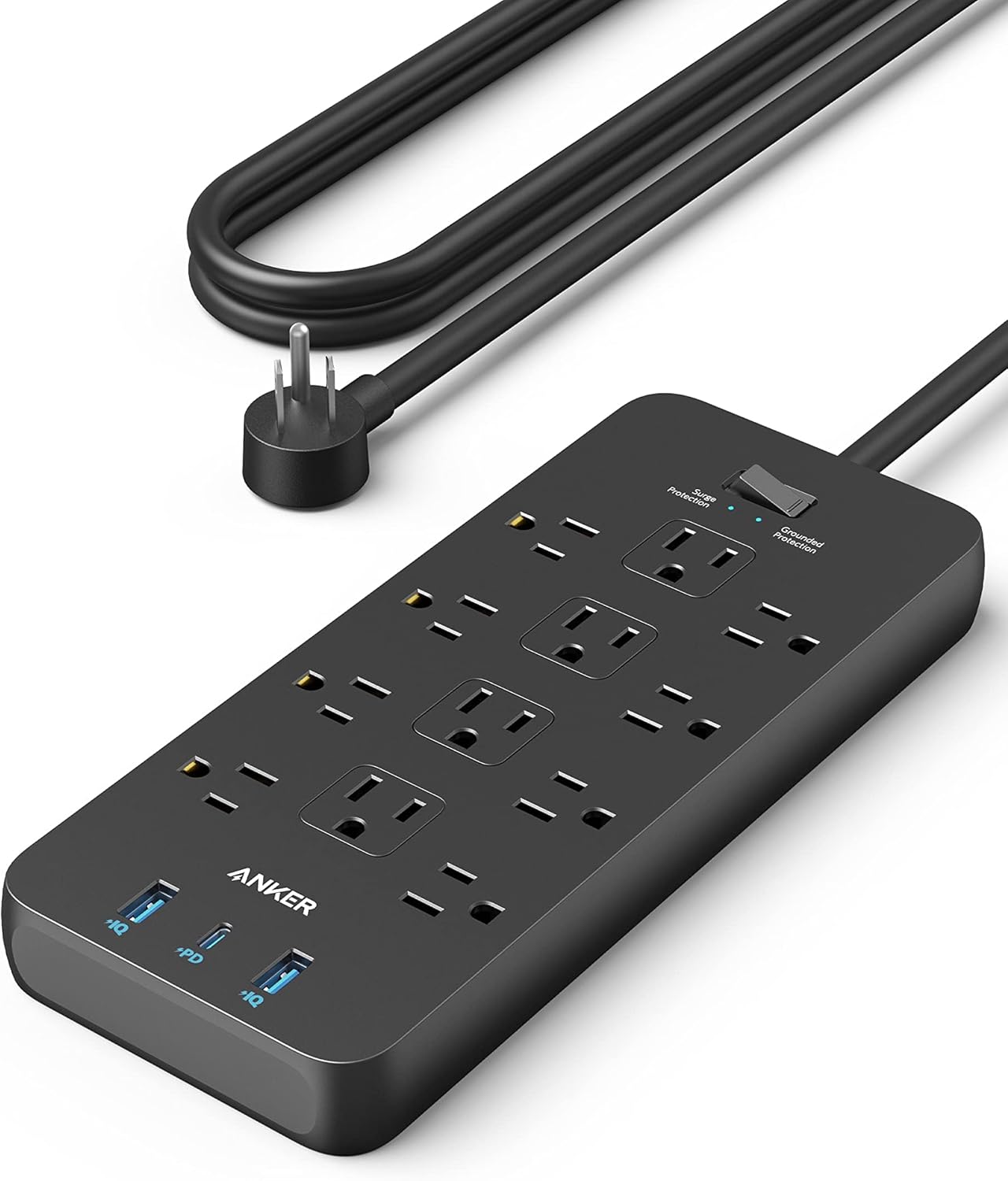
Best Overall for Home & Office Use
The Anker PowerExtend Strip 12 balances power, safety, and convenience. With 12 AC outlets and integrated USB ports, it’s perfect for home offices, entertainment centers, or charging stations in common areas.
2000 joules of surge protection, suitable for protecting PCs, routers, smart TVs, and more.
3 USB-A ports and 1 USB-C port with PowerIQ for optimized charging.
12 grounded AC outlets, spaced to accommodate large power bricks without blocking others.
Built-in circuit breaker and fire-retardant casing enhance safety.
Home offices needing simultaneous power for laptops, monitors, printers.
Living rooms or media setups with multiple devices.
Households that prefer fewer wall chargers thanks to USB integration.
Anker reliability and build quality.
USB-C charging built-in—ideal for modern devices.
Sleek and compact design that fits under desks or behind furniture.
No smart features or app connectivity.
USB ports may not fast-charge laptops or power-hungry tablets.
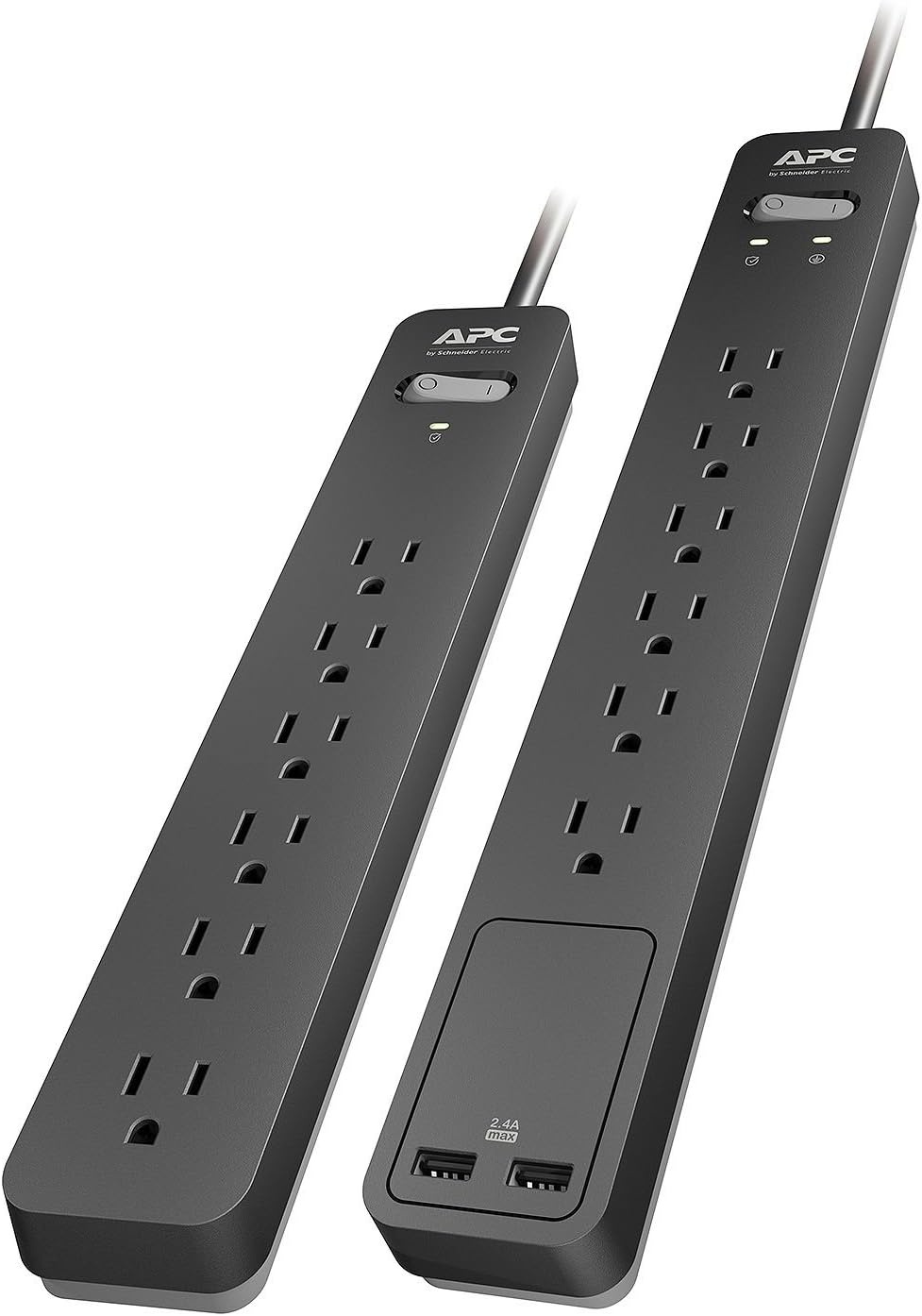
Best for Gaming & Streaming Setups
The APC SurgeArrest Performance Series is designed with gamers and power users in mind. This model includes advanced protection and noise filtering, making it ideal for setups with consoles, PCs, external storage, and streaming equipment.
2880 joules of protection—ample for high-end gaming rigs, monitors, and audio systems.
11 total outlets, including 6 pivoting outlets to accommodate bulky plugs and adapters.
EMI/RFI noise filtering to reduce line interference and improve audio/video quality.
LED indicators show surge protection and grounding status.
Lifetime warranty and equipment protection policy from APC.
Gamers with multiple monitors, RGB lighting, consoles, and charging docks.
Content creators or streamers with microphones, lights, and cameras.
Users who want clean, reliable power without signal interference.
Excellent build quality from a trusted brand.
Angled, rotating plugs keep your setup tidy and efficient.
Superior noise filtering—great for audiophiles or AV users.
Bulky footprint due to rotating plugs.
No USB ports or smart control.
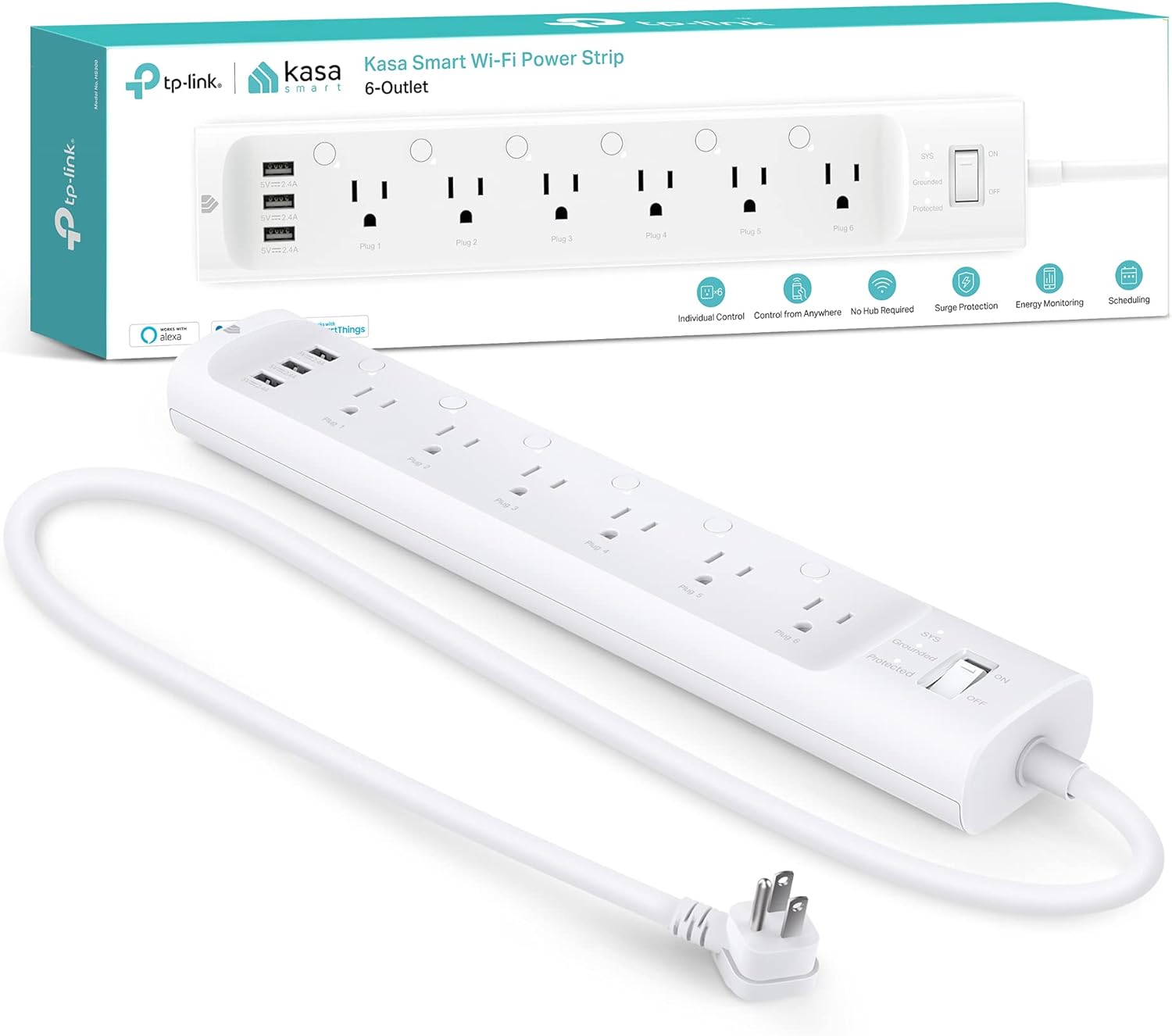
Best for Smart Home Integration
The Kasa Smart HS300 is more than a surge protector—it’s a smart power management system. You get remote control, scheduling, and energy monitoring, making it the ideal choice for tech-savvy users building a connected home.
1710 joules of surge protection, suitable for most home electronics.
6 individually controlled AC outlets, meaning you can power on/off devices separately.
3 USB charging ports built-in for convenience.
Works with Amazon Alexa and Google Assistant for voice control.
Energy monitoring helps track power usage per outlet via the Kasa Smart app.
Smart homes and automation enthusiasts.
Those who want to reduce standby power consumption with scheduling.
People looking to track and manage energy usage.
Highly customizable control for each outlet.
Works well with smart home routines and voice assistants.
Ideal for automating daily appliances, aquarium lights, or workstations.
Not ideal for high-wattage devices like heaters or microwaves.
USB ports are not fast-charging for newer devices.
Must connect to Wi-Fi and the Kasa app to access full features.
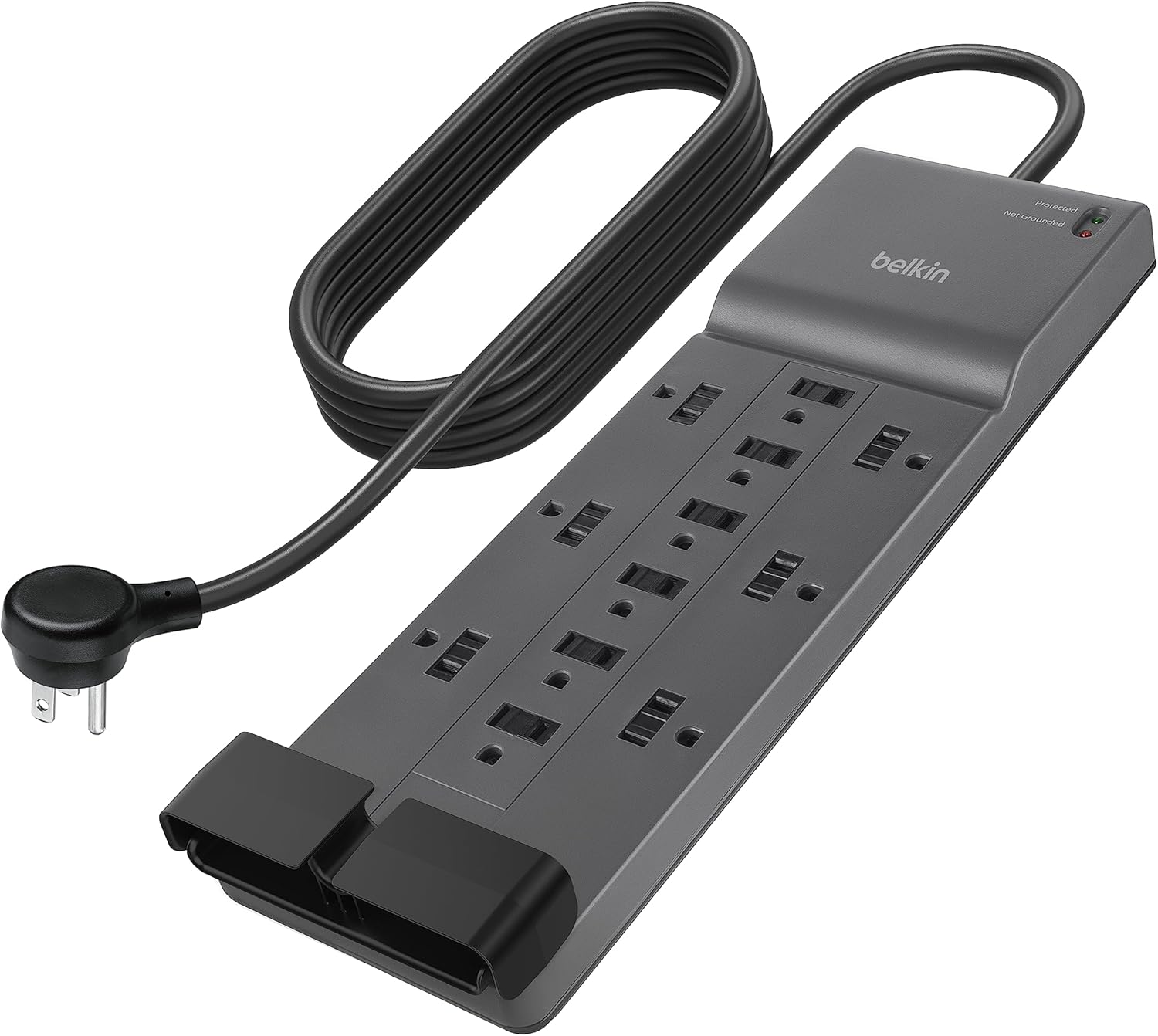
Best High-Capacity Option for Shared Spaces
This Belkin 12-outlet surge protector is a popular classic for good reason: it’s durable, highly protective, and perfect for areas where multiple people need access to outlets—like living rooms, conference rooms, or co-working setups.
3940 joules of surge protection—excellent for sensitive or expensive electronics.
12 outlets, including widely spaced sockets for oversized power bricks.
Sliding safety covers to protect unused outlets from dust and curious fingers.
8-foot heavy-duty power cord for greater placement flexibility.
Built-in cord management clips to reduce clutter.
Shared office desks or entertainment centers with multiple power-hungry devices.
Home theaters, sound systems, or mixed-use setups.
Parents who want extra safety features in family areas.
Extremely high joule rating—longer-lasting surge protection.
Well-spaced outlets reduce plug crowding.
Durable and family-friendly design.
Lacks USB ports and smart features.
Slightly bulky and heavy—better for permanent setups than travel.
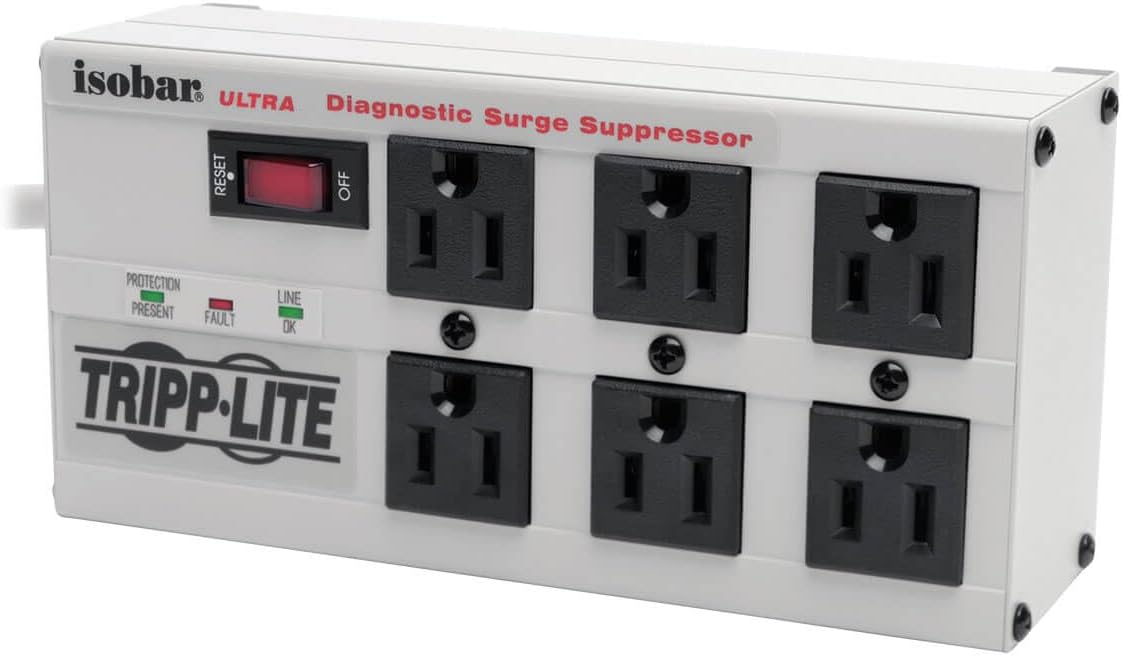
Best for Professional & Industrial Use
The Tripp Lite Isobar Ultra is a legendary product among IT professionals and engineers. With premium surge protection, metal housing, and advanced line noise filtering, it’s ideal for critical office equipment, medical devices, or even industrial workstations.
3330 joules of industrial-grade surge protection.
All-metal housing offers durability and heat resistance.
Isolated filter banks to prevent cross-interference between connected devices.
Diagnostic LEDs for protection and ground status.
Lifetime warranty with connected equipment coverage.
Professional offices with servers, NAS systems, and data backups.
Medical environments and labs needing clean power.
Workshop or studio setups requiring robust build quality.
Built like a tank—virtually indestructible.
Advanced EMI/RFI filtering ideal for sensitive electronics.
Often used in hospitals, data centers, and server rooms.
Basic in appearance—focused on function over aesthetics.
No USB ports or smart functionality.
Fewer total outlets compared to others (typically 6).
| Use Case | Recommended Model | Key Strength |
|---|---|---|
| Home Office / General Use | Anker PowerExtend Strip 12 | USB ports + high joule rating |
| Gaming & Streaming Setups | APC SurgeArrest Gaming Strip | High surge rating + noise filter |
| Smart Home Control | TP-Link Kasa Smart Power Strip | App + voice + energy tracking |
| Shared Living/Work Spaces | Belkin 12-Outlet Surge Protector | Safety features + wide spacing |
| Industrial / Pro Workstations | Tripp Lite Isobar Ultra | Metal housing + isolated filters |
Want to protect your gear with peace of mind? Each of these picks offers a reliable and proven solution for different needs, whether you’re gaming, working remotely, building a smart home, or powering mission-critical devices.
Surge protectors and power strips can make life more convenient, but when misused, they can become serious fire hazards. In fact, overloaded or improperly used power strips are among the top causes of electrical fires in homes and offices.
Here’s how to safely use surge protectors—and avoid costly or dangerous accidents.
“Daisy chaining” means plugging one power strip or surge protector into another—and it’s one of the most common mistakes people make.
Overloads the wall outlet, which can cause overheating and fire.
Compounds the current draw, exceeding the safe capacity of the circuit.
Most surge protectors are not designed to pass through extra load from another power strip.
Safe Practice:
Always plug surge protectors directly into a wall outlet. If you need more outlets, buy a single unit with more sockets—not a chain of cheap strips.
Every power strip has a maximum power rating (usually between 1800–2400 watts). Exceeding that can lead to:
Tripped circuit breakers
Melted insulation
Electrical fires
| Device | Approx. Wattage |
|---|---|
| Space heater | 1500 W |
| Microwave | 1000–1500 W |
| Coffee maker | 800–1200 W |
| Hair dryer | 1200–1800 W |
| Gaming PC + monitor | 500–800 W |
Safe Practice:
Only plug low-wattage electronics into surge protectors. High-wattage appliances should always go into a wall outlet.
Surge protectors are great for electronics—but not for everything.
NEVER plug these into a power strip:
Refrigerators or freezers
Space heaters
Air conditioners
Microwaves
Washing machines or dryers
Toasters or electric kettles
These appliances can cause momentary high power draw (called “inrush current”), which can trip circuits, degrade surge protection, or lead to electrical fires.
If your power strip feels hot to the touch, smells like burnt plastic, or shows discoloration, unplug it immediately.
Signs of trouble include:
Crackling or buzzing sounds
Loose outlets or plugs
Flickering indicator lights
Melted plug prongs
Safe Practice:
Periodically inspect your power strips, especially those hidden behind desks or furniture where airflow is limited.
Surge protectors degrade over time, especially if they’ve absorbed multiple surges. Even if they still power your devices, the protective components may be worn out.
“Protected” LED light: If it’s off, the surge protection is gone.
Age: If your unit is over 3–5 years old, consider replacing it—especially if you live in an area prone to thunderstorms or power grid fluctuations.
Safe Practice:
Make it a habit to mark the installation date on the back of the strip using a permanent marker.
Choose models that include:
Automatic shutoff – Cuts power when surge protection is exhausted.
Circuit breaker / reset switch – Prevents damage from overloads.
Thermal fuse – Disconnects power if internal temperature rises too high.
Childproof outlet covers – Prevents foreign objects from being inserted.
Bonus Tip:
Surge protectors with EMI/RFI filtering reduce electrical noise, which helps protect audio/video equipment from signal interference.
Modifying or taping power strips is dangerous. If the cord or plug is damaged—even slightly—stop using it.
Avoid:
Taping a broken casing.
Twisting exposed wires.
Gluing down loose sockets.
These DIY fixes can lead to arcing, where electricity jumps through the air and ignites nearby material.
Safe Practice:
Dispose of damaged power strips properly. Most electronics stores or recycling centers accept them.
Water and electricity don’t mix. This might sound obvious, but many people accidentally place surge protectors in wet or damp areas, such as:
Under sinks
In bathrooms
Behind kitchen appliances
Near aquariums
Safe Practice:
Use outdoor- or water-resistant surge protectors (IP-rated) if you must place them in high-humidity areas.
Floor-level strips are magnets for:
Spilled drinks
Pet hair
Dust buildup
Accidental unplugging or tripping hazards
Safe Practice:
Mount strips under desks or on walls using the built-in slots or Velcro.
Keep cords organized and labeled to avoid confusion and unplugging the wrong device.
Always read the label on your surge protector. It will include:
Maximum wattage and voltage
Whether it’s rated for indoor or outdoor use
Certification marks (UL, ETL)
Never use a surge protector outside unless it’s specifically rated for outdoor or wet environments.
| ✅ DO | ❌ DON’T |
|---|---|
| Plug directly into the wall | Plug into another power strip |
| Use for electronics & gadgets | Use for heaters or fridges |
| Replace every 2–3 years | Use strips with broken or frayed cords |
| Keep dry & elevated | Put under carpets or near heat |
| Use UL/ETL certified models | Buy unbranded or uncertified strips |
If you’re not using a device for a long period (especially during a storm), it’s smart to unplug it altogether. While surge protectors offer a first line of defense, no system is 100% foolproof against massive surges, like direct lightning strikes. Unplugging removes risk entirely.
In today’s connected world, your electronics aren’t just luxuries—they’re essentials. Whether it’s your home office, gaming setup, smart appliances, or entertainment center, everything relies on a steady, safe stream of power. Yet, many people continue to trust these expensive devices to cheap, unreliable power strips that offer zero protection against electrical surges and fire hazards.
Let’s recap what we’ve learned:
Not all power strips are created equal. A surge protector with a high joule rating and safety certifications is a must-have.
USB and smart features can turn a basic power strip into a productivity powerhouse—while also reducing clutter.
Safe usage practices, like avoiding daisy chaining and checking wattage loads, are just as important as buying the right equipment.
Replacing your surge protector every few years ensures ongoing protection, even if nothing “looks” wrong.
In short, a good surge protector is a small investment that protects your much bigger investments—your devices, your data, and your peace of mind.
Don’t treat electrical safety as an afterthought. Whether you need simple surge protection or a smart, feature-packed powerhouse, the right pick is out there for you. Upgrade your setup today with a trusted, certified surge protector that fits your needs—and sleep easy knowing your electronics are safe.
💬 Have a favorite surge protector or a tip others should know about? Share it in the comments and help others stay safe and connected!
🔌 Ready to make the switch? Scroll back up, explore the top-rated options, and pick the one that suits your home, office, or gaming setup best.
| Cookie | Duration | Description |
|---|---|---|
| cookielawinfo-checbox-analytics | 11 months | This cookie is set by GDPR Cookie Consent plugin. The cookie is used to store the user consent for the cookies in the category "Analytics". |
| cookielawinfo-checbox-functional | 11 months | The cookie is set by GDPR cookie consent to record the user consent for the cookies in the category "Functional". |
| cookielawinfo-checbox-others | 11 months | This cookie is set by GDPR Cookie Consent plugin. The cookie is used to store the user consent for the cookies in the category "Other. |
| cookielawinfo-checkbox-necessary | 11 months | This cookie is set by GDPR Cookie Consent plugin. The cookies is used to store the user consent for the cookies in the category "Necessary". |
| cookielawinfo-checkbox-performance | 11 months | This cookie is set by GDPR Cookie Consent plugin. The cookie is used to store the user consent for the cookies in the category "Performance". |
| viewed_cookie_policy | 11 months | The cookie is set by the GDPR Cookie Consent plugin and is used to store whether or not user has consented to the use of cookies. It does not store any personal data. |